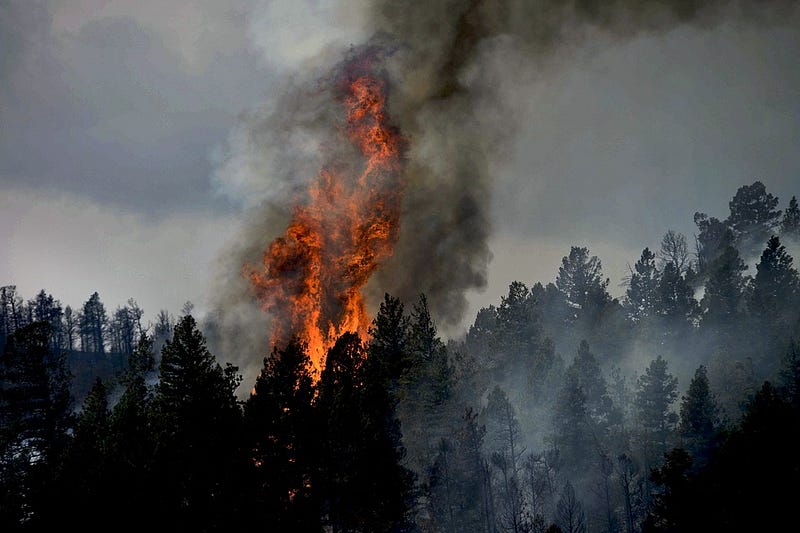Fire’s force for good
By Sanjana Mishra, Computer Science, 2023

Growing up in California, with Smokey Bear grinning down from every billboard remotely near the “wilderness,” I was always against the idea of fire. To me, fires destroyed lives and homes, and caused me to experience respiratory difficulties. The only benefit of a fire was that school was cancelled for a day due to poor air quality, but that came at the cost of thousands of displaced families. Only after moving to Boston do I understand the value of fire as an important component of a healthy environment.
As footage of fires tearing through California plays on televisions across the nation, it can be easy to vilify this force of nature. After all, fires displace hundreds of people each year, and destroy homes and businesses. In fact, the United States Forest Service estimates that around 73,000 wildfires cumulatively destroy about seven million acres of land every year. This number may only increase; climate change makes these blazes more frequent due to higher temperatures and drier weather patterns. With populations expanding, these fires pose a dangerous threat in terms of long-term health, as well as short-term upheaval of lifestyle. Each time there is a threat of a fire, officials encourage residents to evacuate, and in some cases, residents do not have a home upon their return. Additionally, the ash and debris in the air can lead to respiratory issues that can later cause serious health problems. But are forest fires only bad? The short answer is no — fires clear the underbrush for new growth, and are a natural, renewing force of nature. The long answer is a little more nuanced.
The United States Forest Service estimates that around 73,000 wildfires cumulatively destroy about seven million acres of land every year.
Created in 1911, the U.S. Forest Service almost immediately implemented a policy to stamp out forest fires as quickly as possible. This policy was put into action after a fire blazed through Idaho and Montana, killing almost 100 people, and destroying three million acres in only two days. However, in the 1990s, the U.S. Forest Service adopted a more “natural” policy, initiating a program to clear brush and dense forests in order to prevent uncontrolled forest fires. Underbrush, and dry timber from dying trees, fuels uncontrolled fires, but when such fires are prevented, the brush becomes thicker, and dry timber accumulates. By removing the fuel from the forests, the U.S. Forest Service reduces the likelihood of another uncontrollable forest fire. Through this new policy, the U.S. Forest Service extinguishes forest fires close to communities, but also recognizes the importance of forest fires in maintaining a healthy ecosystem.
The U.S. Forest Service now utilizes the technique of controlled, or prescribed burns. Essentially, firefighters set a certain section of a forest on fire, and watch the site to ensure they maintain continual control. By using this method, they can keep these fires away from communities, while maintaining the cycle of undergrowth renewal of a healthy ecosystem. A 40-year-long study by the Tall Timbers Research Station, in Tallahassee, Florida, proved the importance of forest fires to sustaining habitats and biodiversity. During the study, a forest of around 57 acres experienced no fire damage. Over 40 years, plant diversity decreased by 90%, and this “fire-drought” led to the contained extinction of a local bird species, the red-cockaded woodpeckers. These woodpeckers need healthy trees in order to survive, but new growth of vegetation and trees are restricted without the necessary, fiery revitalization of the habitat.
By removing the fuel from the forests, the U.S. Forest Service reduces the likelihood of another uncontrollable forest fire.
While fires can be good for clearing underbrush and revitalizing ecosystems, there are some concerns about the impact on communities as a whole. Along with respiratory issues experienced by people living close to these prescribed burning areas, there is also the risk that a prescribed burn could go wrong, and endanger entire communities.
Fires are not solely bad nor good. When left unchecked near communities, or started recklessly, there can be dangerous consequences. However, the positive outcomes of forest fires — the stimulation of growth in ecosystems, preservation of healthy habitats, and the prevention of larger, deadlier forest fires — show us that nature requires some destruction for the greater good. It can be easy to paint fire as black or white, good or bad, but it is important to remember that fire has the power to damage, create, and conserve.
